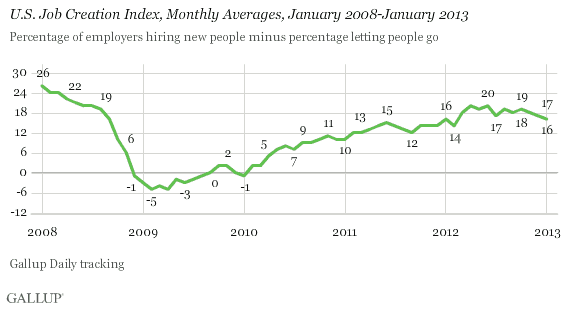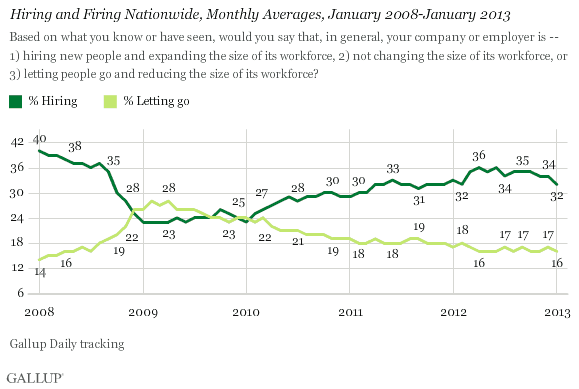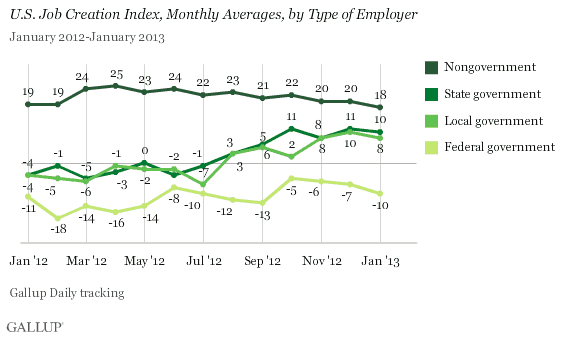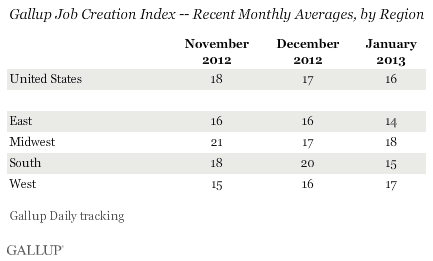PRINCETON, NJ -- The Gallup Job Creation Index averaged +16 in January, the lowest monthly index level in 11 months, after one-percentage-point declines each month since November 2012. Despite this, the index remains fairly high relative to the past four years.

January's results are based on 32% of U.S. adult workers saying their employers are hiring and expanding the size of their workforces, and 16% saying their employers are letting workers go and reducing the size of their workforces.
Both components of the index are down slightly from December. However, the two-point decline in hiring, from 34%, exceeded the one-point decline in workers' being let go, resulting in the one-point drop in the overall index.

Only Federal Hiring Is Net Negative
January also saw the continuation of a decline in hiring in the federal and nongovernment sectors of the economy, a trend that started in November. At the same time, hiring reported by state and local government employees has been fairly steady at the highest levels in more than four years.
As a result of these shifts, the jobs climate appears to be equalizing across the private sector and state and local governments, while hiring by the federal government has become more of an outlier as it has increasingly contracted.

In terms of the longer-term trend, nongovernment hiring, as well as hiring by state and local governments, returned in 2012 to relatively positive levels not seen since 2008. Federal government hiring, on the other hand, has languished well below the levels seen in 2008 and 2009, when the Gallup Job Creation Index for this type of employer was routinely at or above +20.
Midwest Remains Strongest for Hiring
The Job Creation Index varies less by region than by type of employer. As has been typical since late 2010, the Midwest continues to show slightly stronger hiring than the other regions. Net hiring is currently +18 in the Midwest, versus +17 in the West, +15 in the South, and +14 in the East.
The Job Creation Index dropped sharply in the South in January, to +15 from +20 in December, and there was a slight decline in the East, while the hiring picture was statistically unchanged in the Midwest and West. Gallup's February hiring data will help to determine whether the January results are indeed indicative of new hiring problems in the South, or merely a statistical anomaly.

Bottom Line
U.S. job creation faltered slightly in January, with Gallup's Job Creation Index down one point to +16, and down more significantly from +19 in October. This aligns with Gallup's Payroll to Population employment rate, which shows that the total percentage of Americans employed 30 hours or more per week was down slightly in the past month, and by two points since October.
Most of the decline in net hiring in the past few months is due to a weakening of reported hiring by employees working in the private sector as well as in the federal government, while reported hiring by employees of state and local government has held fairly steady.
Several economic factors emerging in 2013 could affect these trends. These include potential drags on the economy from continued debate in the Washington over the budget and the debt ceiling, business uncertainty over the Affordable Care Act, and an apparent slowing of GDP growth in the fourth quarter. At the same time, potential economic spurs include recent major gains in the U.S. stock market, reports of increased consumer spending, and January's major advance in public confidence in the economy.
Gallup.com reports results from these indexes in daily, weekly, and monthly averages and in Gallup.com stories. Complete trend data are always available to view and export in the following charts:
Daily: Employment, Economic Confidence, Job Creation, Consumer Spending
Weekly: Employment, Economic Confidence, Job Creation, Consumer Spending
Read more about Gallup's economic measures.
View our economic release schedule.
Survey Methods
Results are based on telephone interviews conducted as part of Gallup Daily tracking from Jan. 2-31, 2013, with a random sample of 17,434 adults, aged 18 and older, employed full or part time, living in all 50 U.S. states and the District of Columbia, selected using random-digit-dial sampling.
For results based on the total sample of employed adults, one can say with 95% confidence that the maximum margin of sampling error is ±1 percentage point.
Interviews are conducted with respondents on landline telephones and cellular phones, with interviews conducted in Spanish for respondents who are primarily Spanish-speaking. Each sample of national adults includes a minimum quota of 50% cell phone respondents and 50% landline respondents, with additional minimum quotas by region. Landline telephone numbers are chosen at random among listed telephone numbers. Cell phones numbers are selected using random digit dial methods. Landline respondents are chosen at random within each household on the basis of which member had the most recent birthday.
Samples are weighted to correct for unequal selection probability, nonresponse, and double coverage of landline and cell users in the two sampling frames. They are also weighted to match the national demographics of gender, age, race, Hispanic ethnicity, education, region, population density, and phone status (cellphone only/landline only/both, cellphone mostly, and having an unlisted landline number). Demographic weighting targets are based on the March 2012 Current Population Survey figures for the aged 18 and older U.S. population. Phone status targets are based on the July-December 2011 National Health Interview Survey. Population density targets are based on the 2010 census. All reported margins of sampling error include the computed design effects for weighting.
In addition to sampling error, question wording and practical difficulties in conducting surveys can introduce error or bias into the findings of public opinion polls.
For more details on Gallup's polling methodology, visit www.gallup.com.
